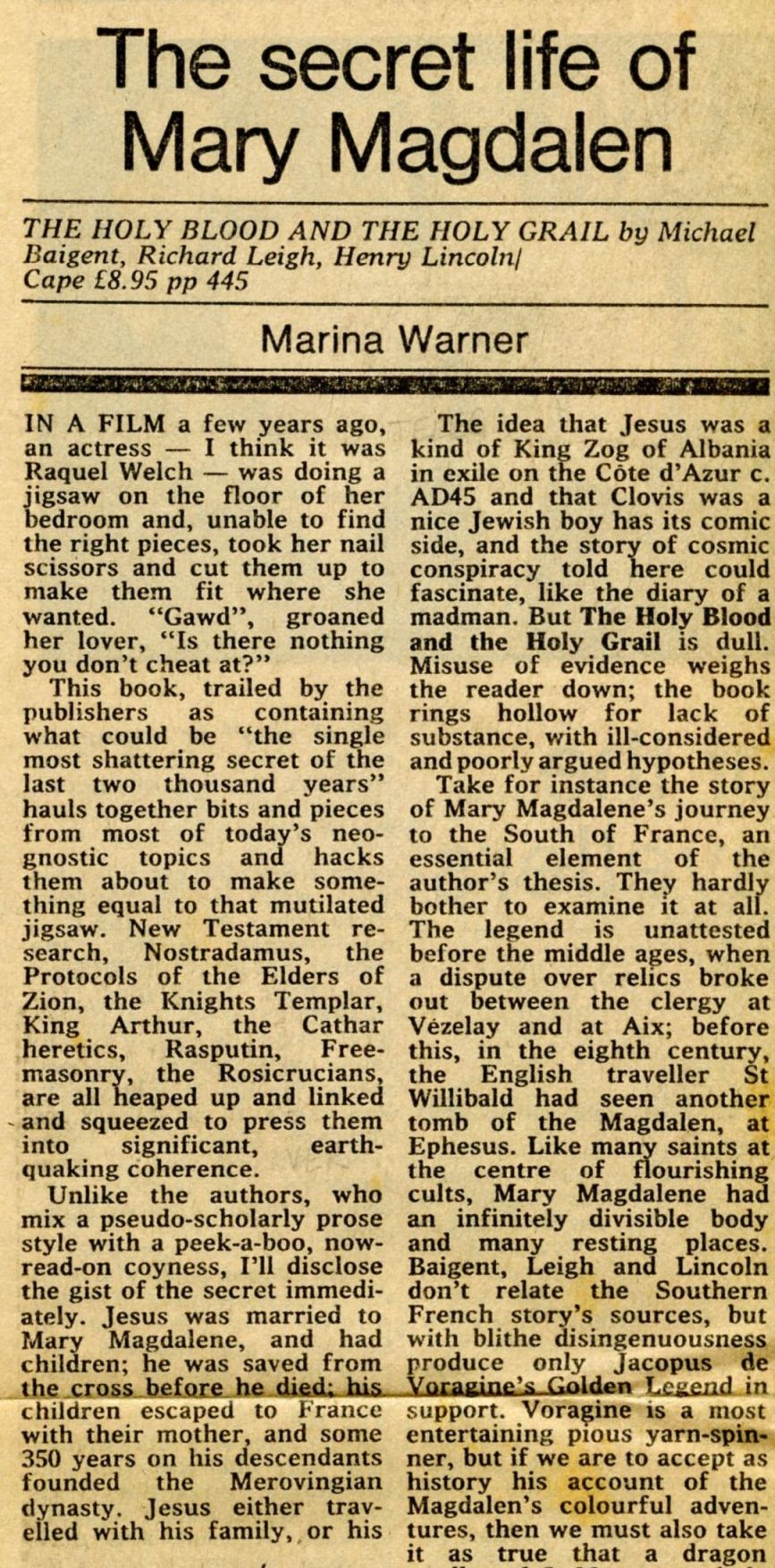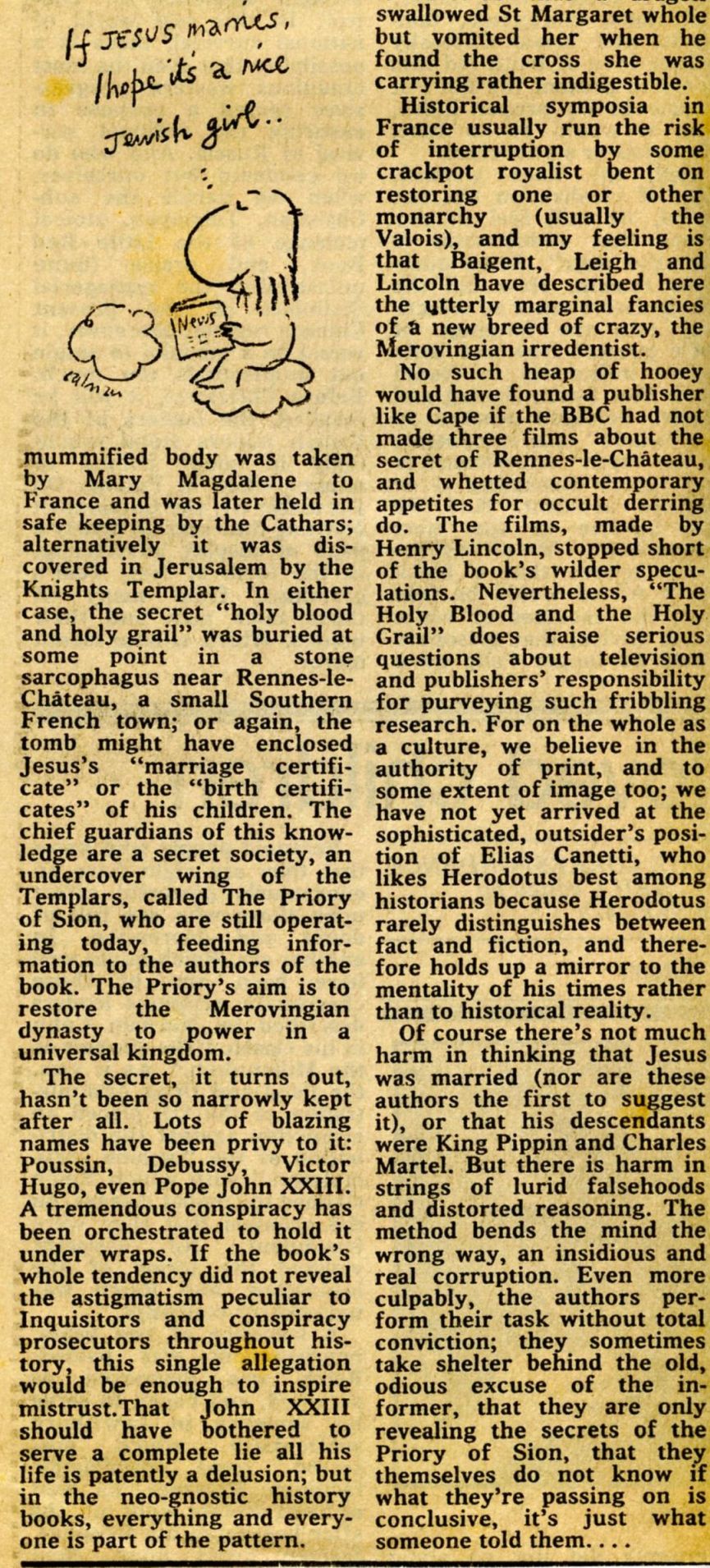The Sunday Times,
17 January 1982
The Secret Life of Mary Magdalene
Marina Warner
(Added 17.7.17)
The Holy Blood and the Holy Grail by Michael Baigent, Richard Leigh, Henry Lincoln.
Cape £8.95 pp 445
IN A FILM a few years ago, an actress – I think it was Raquel Welch – was doing a jigsaw on the floor of her bedroom and, unable to find the right pieces, took her nail scissors and cut them up to make them fit where she wanted. “Gawd”, groaned her lover, “Is there nothing you don't cheat at?”
This book, trailed by the publishers as containing what could be “the single most shattering secret of the last two thousand years” hauls together bits and pieces from most of today's neo-gnostic topics and hacks them about to make something equal to that mutilated jigsaw. New Testament research, Nostradamus, the Protocols of the Elders of Zion, the Knights Templar, King Arthur, the Cathar heretics, Rasputin, Freemasonry, the Rosicrucians, are all heaped up and linked and squeezed to press them into significant, earth-quaking coherence.
Unlike the authors, who mix a pseudo-scholarly prose style with a peek-a-boo, now-read-on coyness, I'll disclose the gist of the secret immediately. Jesus was married to Mary Magdalene, and had children; he was saved from the Cross before he died; his children escaped to France with their mother, and some 350 years on his descendants founded the Merovingian dynasty. Jesus either travelled with his family, or his mummified body was taken by Mary Magdalene to France and was later held in safe keeping by the Cathars; alternatively it was discovered in Jerusalem by the Knights Templar. In either case, the secret “holy blood and holy grail” was buried at some point in a stone sarcophagus near Rennes-le-Chateau, a small southern French town; or again, the tomb might have enclosed Jesus's “marriage certificate” or the “birth certificates” of his children. The chief guardians of this knowledge are a secret society, an undercover wing of the Templars, called the Priory of Sion, who are still operating today, feeding information to the authors of the book. The Priory's aim is to restore the Merovingian dynasty to power in a universal kingdom.
The secret, it turns out, hasn't been so narrowly kept after all. Lots of blazing names have been privy to it: Poussin, Debussy, Victor Hugo, even Pope John XXIII. A tremendous conspiracy has been orchestrated to hold it under wraps. If the book's whole tendency did not reveal the astigmatism peculiar to Inquisitors and conspiracy prosecutors throughout history, this single allegation would be enough to inspire mistrust. That John XXIII should have bothered to serve a complete lie all his life is patently a delusion; but in the neo-gnostic history books, everything and everyone is part of the pattern.
The idea that Jesus was a kind of King Zog of Albania in exile on the Cote d'Azur c.AD45 and that Clovis was a nice Jewish boy has its comic side, and the story of cosmic conspiracy told here could fascinate, like the diary of a madman. But The Holy Blood and the Holy Grail is dull. Misuse of evidence weighs the reader down; the book rings hollow for lack of substance, with ill-considered and poorly argued hypotheses.
Take for instance the story of Mary Magdalene's journey to the South of France, an essential element of the author's thesis. They hardly bother to examine it at all. The legend is unattested before the Middle Ages, when a dispute over relics broke out between the clergy at Vezelay and at Aix; before this, in the eighth century, the English traveller St Willibald had seen another tomb of the Magdalen, at Ephesus. Like many saints at the centre of flourishing cults, Mary Magdalene had an infinitely divisible body and many resting places. Baigent, Leigh and Lincoln don't relate the Southern French story's sources, but with blithe disingenuousness produce only Jacobus de Voragine's Golden Legend in support. Voragine is a most entertaining pious yarn-spinner, but if we are to accept as history his account of the Magdalen's colourful adventures, then we must also take it as true that a dragon swallowed St Margaret whole but vomited her when he found the Cross she was carrying rather indigestible.
Historical symposia in France usually run the risk of interruption by some crackpot royalist bent on restoring one or other monarchy (usually the Valois), and my feeling is that Baigent, Leigh and Lincoln have described here the utterly marginal fancies of a new breed of crazy, the Merovingian irredentist.
No such heap of hooey would have found a publisher like Cape if the BBC had not made three films about the secret of Rennes-le-Château, and whetted contemporary appetites for occult derring do. The films, made by Henry Lincoln, stopped short of the book's wilder speculations. Nevertheless, The Holy Blood and the Holy Grail does raise serious questions about television and publishers' responsibility for purveying such fribbling research. For on the whole as a culture, we believe in the authority of print, and to some extent of image too; we have not yet arrived at the sophisticated, outsider's position of Elias Canetti, who likes Herodotus best among historians because Herodotus rarely distinguishes between fact and fiction, and therefore holds up a mirror to the mentality of his times rather than to historical reality.
Of course there's not much harm in thinking that Jesus was married (nor are these authors the first to suggest it), or that his descendants were King Pippin and Charles Martel. But there is harm in strings of lurid falsehoods and distorted reasoning. The method bends the mind the wrong way, an insidious and real corruption. Even more culpably, the authors perform their task without total conviction; they sometimes take shelter behind the old, odious excuse of the informer, that they are only revealing the secrets of the Priory of Sion, that they themselves do not know if what they're passing on is conclusive, it's just what someone told them....


|



